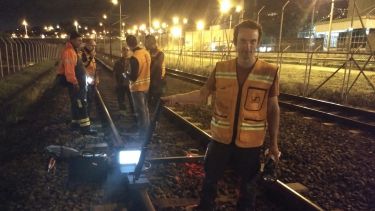Railway Tribology
We are a centre of excellence in all aspects of wheel-rail and overhead line tribology. The team has worked on wear, contact fatigue, rail friction/adhesion, and overhead line durability. Projects have been funded by EU, EPSRC, Network Rail, RSSB, US FRA, and UK industry.

Our research aims to improve the reliability of all aspects of the wheel-rail interface. Early work has been on developing wear models for wheel and rail linked into multi-body dynamics codes for simulating real world performance. We use advanced sensor systems to measure wheel rail contact and rail stress. The image shows Dr Matt Harmon, one of our Research Assistants conducting a series of field trials to measure adhesion conditions in the rail network and investigation traction enhancing products.
Our Expertise and Activities
- We have a range of wheel-rail simulators ranging from lab scale twin-disk testers to a full size wheel on rail simulator. This equipment allows us to test actual section of wheel/rail aerial in representative track conditions. We use the apparatus for developing wear/fatigue laws and the role of friction improvers.
- We have an arc testing machine (exposes overhead line to ~200A current) to study generation of voids and surface softening.
- Advanced ultrasonic sensor systems to measure wheel rail contact and track stress using acousto-elastic methods. Development of lab and field prototypes.
- Prof David Fletcher leads the railway research group MERail at the University. This group conducts fundamental and applied research in the areas of solid mechanics, materials and design for the rail industry. Many of these activities overlap with those of the Leonardo Centre.
- Prof Roger Lewis holds a Royal Academy of Engineering Research Chair co-funded by the Railway Safety and Standards Board, RSSB. His work includes examining the issue of low adhesion, often caused by weather conditions, debris and contamination on the line, and which costs an estimated £350 million a year to the GB rail network and wider society.
- We are members of the UK Rail Research Innovation Network. UKRRIN is formed by a consortium of universities with testing and trialling facilities to deliver collaboration between the rail industry, universities, small and medium-sized business (SMEs), and infrastructure owners to deliver innovations.
Current and Past Research Projects
- Wear and dynamics of overhead line
- Fatigue and crack growth in railway rack
- Arc testing (~200A current) to form white etching layers
- The role of dents and defects in rails steel on track fatigue
- Railway wheel dynamics and profile evolution (EU AWARE)
- Railway Wheel Wear Modelling (EU HIPER Wheel Project)
- Wheel/Rail Damage by Solid Surface Contaminants
- A Railway Wheel Mounted Ultrasonic Sensor for Detecting Flange Contact
- Wheel/Rail Contact Pressure Mapping By Ultrasonic Array
- Railway Overhead Electric Line Wear Testing Machine
- Mapping Rail and Wheel Wear Transitions
- Adhesion sanding of railway track, wear damage and electrical isolation
- Development of friction modifiers and adhesion improvers
- Modelling and experiments on wheel-rail traction
- Super-abrasive grinding of railway track profiles
- Cryogenic leaf layer removal
- Ultrasonic methods for fast measurement of stress in railway track
Contact
Prof David Fletcher, d.i.fletcher@sheffield.ac.uk
Prof Roger Lewis, roger.lewis@sheffield.ac.uk
